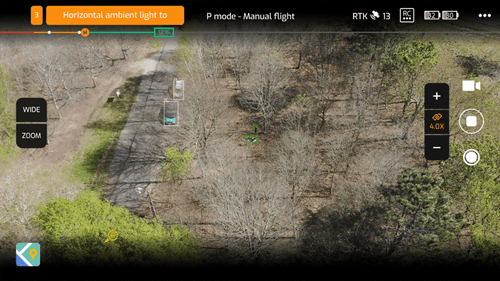TL;DR:
- Aeromedia, Indra, and ITG collaborated to develop DroneFinder, a cutting-edge search and rescue solution.
- The system uses drones equipped with dual video cameras and AI to locate missing persons in real-time.
- DroneFinder optimizes resources, reduces response times, and enhances the chances of successful rescues.
- The first 48 hours are crucial in locating missing persons, especially those with cognitive impairments or disabilities.
- Aeromedia provides hardware and deployment expertise, Indra offers data processing capabilities, and ITG contributes AI-based visual inspection technology.
- Funded by the Xunta de Galicia and the European Union, DroneFinder will be fully operational by the end of 2023.
Main AI News:
In a groundbreaking collaboration, three tech giants, Aeromedia, Indra, and ITG, have joined forces to develop an innovative solution with the potential to revolutionize search and rescue operations. This cutting-edge system, named DroneFinder, aims to swiftly locate missing individuals using drones and Artificial Intelligence (AI), ultimately saving lives in critical situations.
The brainchild of the Galician Emergency Agency, the Aerospace Pole of Galicia, and the Xunta de Galicia, DroneFinder is set to be integrated with the existing systems used by public emergency services, health institutions, and State Security Forces and Corps. This formidable alliance is fueled by financial support from the FEDER funds, reinforcing the commitment to technological advancement in search and rescue operations.
With a staggering 46% of missing persons aged over 70 in Spain suffering from Alzheimer’s disease, the consequences of such disappearances are often fatal. Shockingly, most of these individuals are found merely 3 to 4 kilometers away from their last known location. Additionally, active tourism, natural disasters, and accidents frequently lead to individuals becoming lost and unable to communicate their predicament.
Enter DroneFinder – a game-changing platform that leverages the real-time analysis of vast amounts of images collected by drones equipped with dual video cameras, both RGB and thermal. By harnessing AI capabilities, the system can promptly identify missing persons, even if they are wearing electronic devices like smartwatches or wristbands. The critical information is relayed directly to emergency teams, significantly reducing response times and optimizing search resources, thereby bolstering the chances of successful rescues.
The system’s ultimate mission is to locate missing individuals in record time. The first 48 hours of any search operation are paramount, especially when dealing with people with cognitive impairments, neurodegenerative conditions, or disabilities. DroneFinder stands as a beacon of hope, bringing efficiency and precision to search and rescue efforts.
Aeromedia, a leading expert in RPAS (remotely piloted aircraft systems) services, is a key player in this endeavor. The company boasts a wealth of national experience in search services for missing persons and provides crucial hardware, including tracking devices like smart bracelets, watches, and mobile phones. Additionally, Aeromedia takes charge of deploying the search operation with its fleet of UAVs. The integration of hardware and software, including a user-friendly mobile application, further streamlines search activities.
Indra, the global leader in technological engineering, makes its mark by developing the OPV (Optional Piloted Vehicle) TARGUS aircraft within the scope of the “Civil UAVs Initiative” of the Xunta de Galicia. Their contribution involves the establishment of a sophisticated data processing center that consolidates information from various sources. The People Search Management System (SGBDP) acts as a central hub for data inputs, empowering emergency services and law enforcement with real-time monitoring capabilities. The system’s versatility extends to allow seamless access to proposed functionalities by 112 responders from anywhere with an internet connection or mobile phone coverage.
As a vital component of the project, the ITG Technology Centre lends its expertise in Artificial Vision. Their cutting-edge solution facilitates the automated visual inspection of drone-captured images using AI algorithms. This revolutionary technology processes and analyzes images from the drones’ dual cameras (RGB and thermal) in real-time, with no human intervention required. Day or night, the AI-powered system rapidly analyzes vast volumes of imagery, exponentially increasing the likelihood of locating missing individuals.
Under the auspices of the Civil UAVs Initiative and the Strategic Programme 2021-2025, the Xunta de Galicia champions the DroneFinder project. Crucially, this technological marvel is being funded under the REACT-EU axis of the Galicia ERDF Operational Programme 2014-2020, a testament to the European Union’s commitment to countering the challenges posed by the COVID-19 pandemic. The ambitious DroneFinder project is set to achieve full operational status by the end of 2023, heralding a new era of efficient search and rescue operations, powered by the seamless integration of drones and AI.
Conclusion:
The collaboration between Aeromedia, Indra, and ITG has resulted in the revolutionary DroneFinder system, combining drones and AI to significantly improve search and rescue operations. This technological advancement will not only save lives but also enhance the efficiency of emergency services. As this technology matures and gains wider acceptance, we can expect a surge in demand for similar innovative solutions in the search and rescue market. Companies in the aerospace and AI sectors should take note of this successful partnership as they explore opportunities to provide cutting-edge solutions to address real-world challenges in the future.

